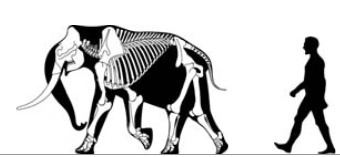 | ||
Biological rules describe patterns seen in animals and plants, often as ecogeographical rules about the distribution of species around the world. Many of these regularities of ecology and biogeography are named after the people who first described them.
Contents
Rules
Allen's rule states that the body shapes and proportions of endotherms vary by climatic temperature by either minimizing exposed surface area to minimize heat loss in cold climates or maximizing exposed surface area to maximize heat loss in hot climates. It is named after Joel Asaph Allen who described it in 1877.
Bergmann's rule states that within a broadly distributed taxonomic clade, populations and species of larger size are found in colder environments, and species of smaller size are found in warmer regions. It applies with exceptions to many mammals and birds. It was named after Carl Bergmann who described it in 1847.
Cope's rule states that animal population lineages tend to increase in body size over evolutionary time. The rule is named for the palaeontologist Edward Drinker Cope.
Foster's rule or the Island rule states that members of a species get smaller or bigger depending on the resources available in the environment. The rule was first stated by J. Bristol Foster in 1964 in the journal Nature, in an article titled "The evolution of mammals on islands".
Gause's law or the competitive exclusion principle states that two species competing for the same resource cannot coexist at constant population values. The competition leads either to the extinction of the weaker competitor or to an evolutionary or behavioral shift toward a different ecological niche.
Gloger's rule states that within a species of endotherms, more heavily pigmented forms tend to be found in more humid environments, e.g. near the equator. It was named after the zoologist Constantin Wilhelm Lambert Gloger, who described it in 1833.
Haldane's rule states that if in a species hybrid only one sex is sterile, that sex is usually the heterogametic sex. The heterogametic sex is the one with two different sex chromosomes; in mammals, this is the male, with XY chromosomes. It is named after J.B.S. Haldane.
Hennig's progression rule states that when considering a group of species in cladistics, the species with the most primitive characters are found within the earliest part of the area, which will be the center of origin of that group. It is named for Willi Hennig, who devised the rule.
Jordan's rule states that there is an inverse relationship between water temperature and meristic characteristics such as the number of fin rays, vertebrae, or scale numbers, which are seen to increase with decreasing temperature. It is named after the father of American ichthyology, David Starr Jordan.
Rapoport's rule states that the latitudinal ranges of plants and animals are generally smaller at lower latitudes than at higher latitudes. It was named after Eduardo H. Rapoport by G. C. Stevens in 1989.
Rensch's rule states that across animal species within a lineage, sexual size dimorphism increases with body size when the male is the larger sex, and decreases as body size increases when the female is the larger sex. The rule applies in primates, pinnipeds (seals), and even-toed ungulates (such as cattle and deer). It is named after Bernhard Rensch, who proposed it in 1950.
Thorson's rule states that benthic marine invertebrates at low latitudes tend to produce large numbers of eggs developing to pelagic (often planktotrophic [plankton-feeding]) and widely dispersing larvae, whereas at high latitudes such organisms tend to produce fewer and larger lecithotrophic (yolk-feeding) eggs and larger offspring, often by viviparity or ovoviviparity, which are often brooded. It was named after Gunnar Thorson by S. A. Mileikovsky in 1971.
Validity
There is some scepticism among biogeographers about the usefulness of general rules. For example, J.C. Briggs, in his 1987 book Biogeography and Plate Tectonics, comments that while Willi Hennig's rules on cladistics "have generally been helpful", his progression rule is "suspect".
